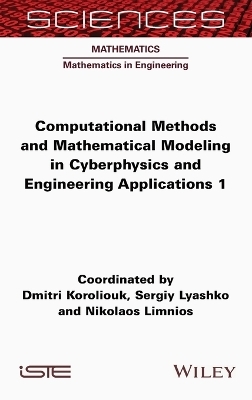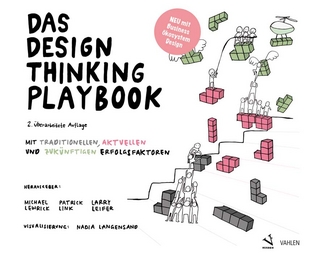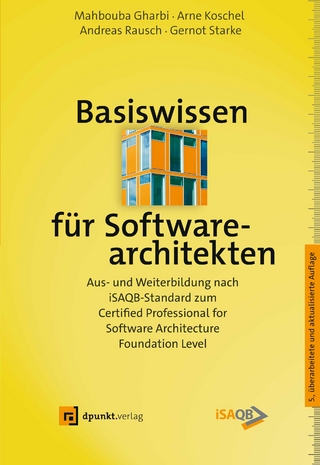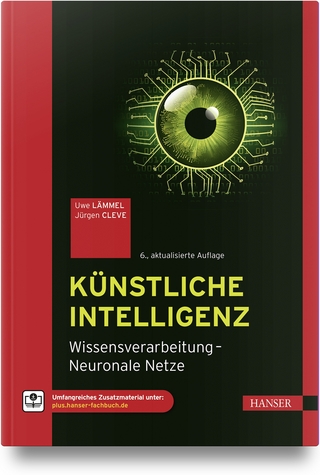
Computational Methods and Mathematical Modeling in Cyberphysics and Engineering Applications 1
Iste Ltd (Verlag)
978-1-78945-164-1 (ISBN)
Computational Methods and Mathematical Modeling in Cyberphysics and Engineering Applications contains solutions to specific problems in current areas of computational engineering and cyberphysics.
Dmitri Koroliouk is a Doctor of Sciences, Professor at the National Technical University of Ukraine "Igor Sikorsky Kyiv Polytechnic Institute", and leading researcher at the Institute of Mathematics, and at the Institute of Telecommunications and Global Information Space of the National Academy of Sciences of Ukraine. He is also Head of the Digital Innovation Laboratory at UNESCO Interdisciplinary Chair in Biotechnology and Bioethics at the University of Rome Tor Vergata, Italy. Sergiy Lyashko is Head of the Department of Computational Mathematics at the Faculty of Computer Sciences and Cybernetics, Taras Shevchenko National University of Kyiv, and a professor at the National Academy of Sciences of Ukraine. His research interests concern problems of singular optimal control of linear systems. Nikolaos Limnios is a professor at the Laboratoire de Mathématiques Appliquées, Université de Technologie de Compiègne, France. His research interests concern statistical inference for stochastic processes and semi-Markov processes.
Preface xi
Dmitri KOROLIOUK
Chapter 1 The Hydrodynamic-type Equations and the Solitary Solutions 1
Sergiy LYASHKO, Valerii SAMOILENKO, Yuliia SAMOILENKO and Ihor GAPYAK
1.1 Introduction 1
1.2 The Korteweg-de Vries equation and the soliton solutions 3
1.3 The Korteweg-de Vries equation with a small perturbation 4
1.4 The linear WKB technique and its generalization 7
1.5 Acknowledgments 11
1.6 References 11
Chapter 2 The Nonlinear WKB Technique and Asymptotic Soliton-like Solutions to the Korteweg-de Vries Equation with Variable Coefficients and Singular Perturbation 15
Sergiy LYASHKO, Valerii SAMOILENKO, Yuliia SAMOILENKO and Evgen VAKAL
2.1 Introduction 16
2.2 Main notations and definitions 18
2.3 The structure of the asymptotic one-phase soliton-like solution 19
2.4 The KdV equation with quadratic singularity 20
2.5 Equations for the regular part of the asymptotics and their analysis 22
2.6 Equations for the singular part of the asymptotics and their analysis 24
2.6.1 The main term of the singular part 25
2.6.2 The higher terms of the singular part and the orthogonality condition 26
2.6.3 The orthogonality condition and the discontinuity curve 29
2.6.4 Prolongation of the singular terms from the discontinuity curve 34
2.7 Justification of the algorithm 38
2.8 Discussion and conclusion 44
2.9 Acknowledgments 45
2.10 References 45
Chapter 3 Asymptotic Analysis of the vcKdV Equation with Weak Singularity 49
Sergiy LYASHKO, Valerii SAMOILENKO, Yuliia SAMOILENKO and Nataliia LYASHKO
3.1 Introduction 50
3.2 The asymptotic soliton-like solutions 51
3.3 The examples of the asymptotic soliton-like solutions 56
3.3.1 The asymptotic step-wise solutions 57
3.3.2 The asymptotic solutions of soliton type 61
3.4 Discussion and conclusion 66
3.5 Acknowledgments 66
3.6 References 66
Chapter 4 Modeling of Heterogeneous Fluid Dynamics with Phase Transitions and Porous Media 69
Gennadiy V SANDRAKOV
4.1 Introduction 69
4.2 The large particle method 72
4.3 The particle-in-cell method 79
4.4 Modeling of heterogeneous fluid dynamics 83
4.5 Modeling of heterogeneous fluid dynamics with phase transitions 88
4.6 Modeling of viscous fluid dynamics and porous media 94
4.7 References 98
Chapter 5 Mathematical Models and Control of Functionally Stable Technological Process 101
Volodymyr PICHKUR, Valentyn SOBCHUK and Dmytro CHERNIY
5.1 Introduction 101
5.2 Analysis of production process planning procedure 104
5.3 Mathematical model of the production process management system of an industrial enterprise 108
5.4 Control design 111
5.5 Algorithm of control of production process 115
5.6 Conclusion 116
5.7 Acknowledgments 117
5.8 References 118
Chapter 6 Alternative Direction Multiblock Method with Nesterov Acceleration and Its Applications 121
Vladislav HRYHORENKO, Nataliia LYASHKO, Sergiy LYASHKO and Dmytro KLYUSHIN
6.1 Introduction 121
6.2 Proximal operators 122
6.3 ADMM (alternating direction method of multipliers) 128
6.4 Bregman iteration 131
6.5 Forward-backward envelope (FBE) 132
6.6 Douglas-Rachford envelope (DRE) 133
6.7 Proximal algorithms for complex functions 134
6.8 Fast alternative directions methods 137
6.9 Numerical experiments 142
6.9.1 Exchange problem 142
6.9.2 Basis pursuit problem 143
6.9.3 Constrained LASSO problem 144
6.10 Conclusion 145
6.11 References 145
Chapter 7 Modified Extragradient Algorithms for Variational Inequalities 149
Vladimir V SEMENOV and Sergey V DENISOV
7.1 Introduction 149
7.2 Preliminaries 149
7.3 Overview of the main algorithms for solving variational inequalities and approximations of fixed points 156
7.4 Modified extragradient algorithm for variational inequalities 164
7.5 Modified extragradient algorithm for variational inequalities and operator equations with a priori information 173
7.6 Strongly convergent modified extragradient algorithm 177
7.6.1 Algorithm variant for variational inequalities 178
7.6.2 Variant for problems with a priori information 193
7.7 References 199
Chapter 8 On Multivariate Algorithms of Digital Signatures on Secure El Gamal-Type Mode 205
Vasyl USTIMENKO
8.1 On post-quantum, multivariate and non-commutative cryptography 206
8.2 On stable subgroups of formal Cremona group and privatization of multivariate public keys based on maps of bounded degree 208
8.3 Multivariate Tahoma protocol for stable Cremona generators and its usage for multivariate encryption algorithms 211
8.4 On multivariate digital signature algorithms and their privatization scheme 214
8.5 Examples of stable cubical groups 216
8.5.1 Simplest graph-based example 216
8.5.2 Other stable subgroups defined via linguistic graphs 219
8.5.3 Special homomorphisms of linguistic graphs and corresponding semigroups 222
8.5.4 Example of stable subsemigroups of arbitrary degree 223
8.6 Conclusion 225
8.7 References 227
Chapter 9 Metasurface Model of Geographic Baric Field Formation 231
Dmitri KOROLIOUK, Maksym ZOZIUK, Pavlo KRYSENKO and Yuriy YAKYMENKO
9.1 Introduction 231
9.2 The parametric scalar field model principle 233
9.3 Local isobaric scalar field model 234
9.4 Modeling Chladni figures based on the proposed model 235
9.5 The frequency of forcing influences and the problem of its detection 237
9.6 Conclusion 239
9.7 References 241
Chapter 10 Simulation of the Electron-Hole Plasma State by Perturbation Theory Methods 245
Andrii BOMBA, Sergiy LYASHKO and Ihor MOROZ
10.1 Introduction Nonlinear boundary value problems of the p-i-n diodes theory 245
10.2 Construction of an asymptotic solution of a boundary value problem for the system of the charge carrier current continuity equations and the Poisson equation 249
10.3 Simulation of the charge carriers’ stationary distribution in the electron-hole plasma of the p-i-n diode assembly elements 262
10.4 Modeling the charge carriers stationary distribution in the active region of the integrated surface-oriented p-i-n structures 264
10.5 Final considerations 270
10.6 References 271
Chapter 11 Diffusion Perturbations in Models of the Dynamics of Infectious Diseases Taking into Account the Concentrated Effects 273
Serhii BARANOVSKY, Andrii BOMBA, Sergiy LYASHKO and Oksana PRYSHCHEPA
11.1 Introduction 273
11.2 Model problem of infectious disease dynamics taking into account diffusion perturbation and asymptotics of the solution 277
11.3 Modeling of diffusion perturbations of infectious disease process taking into account the concentrated effects and immunotherapy 282
11.4 Modeling the influence of diffusion perturbations on development of infectious diseases under convection 288
11.5 Numerical experiment results 292
11.6 Conclusion 300
11.7 References 301
Chapter 12 Solitary Waves in the "Shallow Water" Environments 305
Yurii TURBAL, Mariana TURBAL and Andrii BOMBA
12.1 Introduction 305
12.2 T-forms for the solitary wave approximation 307
12.3 Existence of the solution of the gas dynamics equations in the form of solitary waves 313
12.4 Analysis of the localized wave trajectories 332
12.5 Numerical results 338
12.6 Conclusion 341
12.7 References 342
Chapter 13 Instrument Element and Grid Middleware in Metrology Problems 345
Pavlo NEYEZHMAKOV, Stanislav ZUB, Sergiy LYASHKO, Irina YALOVEGA and Nataliia LYASHKO
13.1 Introduction 345
13.2 Security in the grid 347
13.3 Grid element for measuring instruments 347
13.4 Grid and some problems of metrology 350
13.5 Discussion and conclusion 352
13.6 References 352
Chapter 14 Differential Evolution for Best Uniform Spline Approximation 355
Larysa VAKAL and Evgen VAKAL
14.1 Introduction 356
14.2 Problem statement 356
14.3 Review of methods for spline approximation 357
14.4 Algorithm 359
14.5 Experimental results and discussion 362
14.6 Conclusion 364
14.7 References 365
Chapter 15 Finding a Nearest Pair of Points Between Two Smooth Curves in Euclidean Space 367
Vladimir V SEMENOV, Nataliia LYASHKO, Stanislav ZUB and Yevhen HAVRYLKO
15.1 Introduction 367
15.2 Define the problem and notations 368
15.3 Lagrange function with energy dissipation 369
15.4 Lagrange equation 370
15.5 Hamiltonian equations 372
15.6 Numerical experiments 376
15.7 Concluding remarks 378
15.8 References 379
Chapter 16 Constrained Markov Decision Process for the Industry 381
Michel BOUSSEMART and Nikolaos LIMNIOS
16.1 Introduction 381
16.2 Introduction to constrained Markov decision processes 382
16.2.1 Introduction 382
16.2.2 Model 383
16.2.3 Economic criteria 384
16.2.4 Infinite horizon expected discounted reward 386
16.2.5 Infinite horizon expected average reward 392
16.3 Markov decision process with a constraint on the asymptotic availability 396
16.3.1 Introduction 396
16.3.2 Model 397
16.3.3 Algorithm 399
16.3.4 Application 399
16.4 Markov decision process with a constraint on the asymptotic failure rate 408
16.4.1 Introduction 408
16.4.2 Model 409
16.4.3 Algorithm 413
16.4.4 Application 413
16.5 Conclusion 418
16.6 References 419
List of Authors 423
Index 427
| Erscheinungsdatum | 11.05.2024 |
|---|---|
| Verlagsort | London |
| Sprache | englisch |
| Gewicht | 907 g |
| Themenwelt | Mathematik / Informatik ► Informatik ► Datenbanken |
| Informatik ► Software Entwicklung ► User Interfaces (HCI) | |
| Naturwissenschaften ► Physik / Astronomie | |
| ISBN-10 | 1-78945-164-7 / 1789451647 |
| ISBN-13 | 978-1-78945-164-1 / 9781789451641 |
| Zustand | Neuware |
| Informationen gemäß Produktsicherheitsverordnung (GPSR) | |
| Haben Sie eine Frage zum Produkt? |
aus dem Bereich


